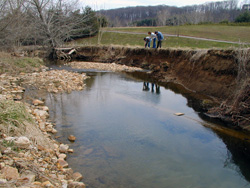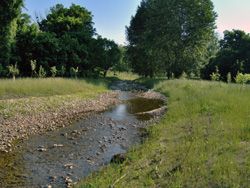Riparian Zone and Stream Restoration
Introduction
With the right techniques, stream channels and corridors (riparian zones) can be restored and reconstructed to improve habitat for fish and to stabilize banks against erosion and incision (gouging). Such efforts can serve to benefit water quality; however, the effectiveness of restoration for improving surface or groundwater quality has not been thoroughly assessed. The same techniques can be used to remove or reduce nutrients that have detrimental effects on human health and aquatic life. For example, nitrogen, which is required in small amounts for growth of living organisms, can pose health risks when concentrations are high. Excess nitrogen enters streams from fertilizer runoff, animal wastes, sewer lines, and atmospheric deposition of nitrous oxides from fossil fuel combustion (e.g., automobile exhaust). Ecological restoration is used to enhance the ability of a stream to naturally remove nitrogen through denitrification, a process performed naturally by microorganisms in the water and subsurface. EPA scientists are examining the effects of stream restoration on water quality in Baltimore, Maryland, where a degraded urban stream (Minebank Run) has been restored to stabilize stream banks and reduce further channel erosion. The objectives of the Minebank Run project were to assess the ecosystem benefits of restoration and to identify stream restoration methods that enhance nitrogen control or otherwise improve water quality. When such methods are identified, EPA can develop ecologically based guidelines for stream restoration and share this information with land managers who have a need to restore the ecological health of streams and riparian zones, and improve water quality for residents in the watershed. References and ProductsGauging the Effectiveness of Riparian Buffers – Research Highlights June 2009 Assessment of Near-Stream Ground Water-Surface Water Interaction (GSI) of a Degraded Stream Before Restoration (EPA/600/R-07/058) August 2008 Research Shows Importance of Riparian Buffers for Aquatic Health – Science in Action (PDF) (1 pp, 148 KB) June 2007 Restored Streams Enhance Ability to Remove Nitrogen – Science in Action (PDF) (1 pp, 532 KB) June 2007 U.S EPA and U.S. Geological Survey. (2007). “Pre-Restoration Geomorphic Characteristics of Minebank Run, Baltimore County, Maryland, 2002–04 (PDF).” (64 pp, 5.51 MB) U.S. EPA and U.S. Geological Survey. (2006). Watershed Characteristics and Pre-Restoration Surface-Water Hydrology of Minebank Run, Baltimore County, Maryland, Water Years 2002–04 (PDF) (54 pp, 6.78 MB) Helping Streams Help Themselves, Naturally. April 2006 US EPA. (2005) "Riparian Buffer Width, Vegetative Cover, and Nitrogen Removal Effectiveness: A Review of Current Science and Regulations." Publication No. EPA/600/R-05/118. - Abstract ProjectsEffectiveness of Riparian Buffers for Managing Nitrogen (PDF) (2 pp, 270 KB) ContactPaul Mayer
You will need Adobe Reader to view some of the files on this page. |
![[logo] US EPA](../gif/logo_epaseal.gif)

